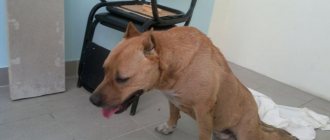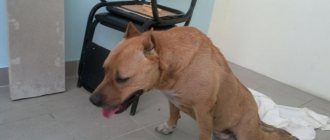What diseases cause paralysis?
In dogs, paresis of the hind legs (partial loss of sensation) or paralysis (complete loss of mobility) causes diseases that can develop unnoticed for a long time. Among these causes are injuries, degenerative diseases of the spine and joints, and neurological pathologies.
The inability to stand on your paws is the final symptom. It indicates the transition of the defect to the final stage of development, which is difficult to stop. Paralysis usually occurs suddenly: in the morning the dog was happily running around, but a few hours later it lies down and refuses to get up.
Physical damage
Various injuries lead to damage to joints, bones, tendons, and nerves. Injuries to the spine are especially dangerous - they change the integrity of the structure and cause swelling, which puts pressure on the spinal cord and disrupts innervation.
The dog can get hurt during:
- active games;
- fights with relatives;
- car accidents – a dog can be hit by a car if it is walking unattended;
- falls from a height - and the elevation does not have to be large; small breeds (toy terriers, Yorkies) are often injured when jumping from sofas, tables, armchairs;
- sharp turn while running.
The most favorable outcome is if the pet simply injured its paw or its pad. In this case, he will be restless, whine when he sits down, limp or drag a limb.
Symptoms of the disease
If an animal's hind legs fail after an accident or any other injury, the owners are, in principle, prepared for the complications that may arise. It’s another matter when outwardly the diseases do not manifest themselves in any way. Problems appear like a bolt from the blue.
The animal’s legs simply give way, it staggers, trying to get up, whines, suffers, and the owners cannot understand how this happened. Sometimes a dog cannot stand on its hind legs immediately after sleep, in other cases everything happens against the background of external complete well-being.
It can be very difficult to notice the problem until the animal begins to limp or simply cannot move. Sometimes the disease begins with pain with sudden movements, which turns into severe sharp pain. The animal suffers when moving, so it tries to limit its mobility.
Owners can detect the disease by a change in the dog’s behavior - it lies down a lot, stops running, stops playing, gets up reluctantly and slowly and goes to the owner’s call. The dog's gait becomes shaky, uncertain, he moves with obvious difficulty, and may drag his paw or limp.
Heavy, "raw" dogs such as St. Bernards often suffer from hip dysplasia. A characteristic sign of the disease is stiffness of movement after sleep or long rest, then mobility is restored during the day, and the next day everything repeats.
Paralysis rarely develops in the anterior half of the body; in most dogs, arthritis, spondylosis, osteochondrosis, discopathy and other spinal problems are more often diagnosed in the thoracic and lumbar region.
Sometimes an animal’s paws can give way immediately after an unsuccessful jump or turn. This does not mean that it was the awkward movement that caused the paresis or paralysis. Most likely, the disease had been developing latently for a long time, and a sudden movement simply became a catalyst that accelerated its manifestation.
If your dog's legs are paralyzed, what should you do and what should you not do?
No home methods will help if a dog loses its paws. She should be taken to a veterinary clinic immediately.
It is advisable to pay attention to the early symptoms of paresis - restlessness, stooping, lameness, refusal to play, and rapid fatigue. The faster the disease is identified, the more successful the treatment will be.
There is no point in delaying your visit to the doctor. Even a slight limp can eventually turn into complete paralysis and the dog will have to be euthanized. It is advisable to contact a veterinarian specializing in neurological pathologies.
If there is loss of sensation in the limbs, it is strictly prohibited:
- apply cold or heat to the affected areas;
- massage the spine or paws;
- make the dog move - it’s better to pick him up and carry him home or to the clinic in your arms.
If spinal injuries are suspected, absolute immobility must be ensured. A board is carefully placed under the pet (you can ask two other people to carefully lift the dog) and tied with bandages, ribbons or belts.
You cannot give painkillers - if the pain subsides, the dog will begin to move, which will lead to displacement of the vertebrae.
Symptoms of Hind Leg Failure in Dogs
You may notice the first signs of a problem while walking. If they appear after sudden movements (for example, during games), then do not consider the activity to be the cause of the disease. Rather, the movement provokes symptoms of an existing problem. Symptoms of hind leg failure in dogs are extremely unpleasant:
- The dog cannot move normally
- Hind legs weaken and become unruly
- As a result, paralysis of the pelvic limbs or paresis may develop.
Manifestations of the disease do not always occur all at once. Sometimes in the morning the dog feels pain, and in the evening the deplorable signs and consequences of paralysis of the limbs are already obvious.
Features of treatment for limb failure
To identify pathology, the veterinarian carries out:
- visual examination - assessment of general condition, checking sensitivity, reflexes and pain reactions;
- X-ray examination or MRI;
- myelography - x-ray examination with a contrast agent;
- general clinical urine and blood tests.
Further treatment tactics vary significantly depending on the disease that caused the immobility.
Treatment is usually prescribed:
- Operational.
Surgery is performed to eliminate the provoking factor.- Physiotherapeutic.
Complements surgical and drug treatment.- Medication.
Special medications are prescribed, different for each type of disease.It can be:
- antibiotics;
- antispasmodics;
- analgesics;
- non-steroidal anti-inflammatory drugs;
- immunomodulators;
- medications that improve nerve conduction, blood supply and regeneration.
Regardless of the type of disease and prescribed therapy, it is necessary to create a special diet. All products should be easily digestible and nutritious, contain a lot of calcium, selenium, sulfur, protein, and fatty acids.
Causes of pathology
Paralysis occurs for the following reasons:
- Spinal cord injuries.
- Discopathy is damage to the intervertebral discs.
- Degenerative myelopathy. A hereditary disease that appears in older dogs after 7 years of age.
- Discospondylitis. Inflammation of the epiphyses of the dorsal vertebrae of infectious etiology.
- Complications after the nervous type of canine distemper. Additional signs are damage to the respiratory system, conjunctivitis, rhinitis, cough, green feces.
- Autoimmune inflammation of the meninges in the spinal cord.
- Polyneuritis is a lesion of peripheral nerves characterized by tetraplegia.
- Neosporosis is a protozoal invasion caused by coccidia. Hunting dogs are predisposed. Additional signs include difficulty swallowing, loss of vision.
- Complications after ear or dental diseases. Inflammation spreads to the brain. Most often, the trigeminal nerve is pinched, which leads to sagging of the lower jaw.
- Botulism is a toxic infection caused by eating spoiled food or carrion.
- Hypothyroidism is a dysfunction of the thyroid gland, which affects the skin, eyes, hair loss, and obesity develops.
- Piroplasmosis is an invasion caused by Babesia, single-celled parasites that enter the body with the saliva of the ixodid tick. In addition to paralysis, the dog is at risk of anemia, hyperthermia, yellowness of the mucous membranes, and brown urine.
- Malignant neoplasms in the vertebrae.
Watch the video:
What breeds are at risk?
Some breeds are more likely to lose their paws than others. This is explained by strict selection, forced changes in the skeleton for the sake of working or decorative qualities.
Typically, leg failure occurs in young and adult pets between 3 and 8 years of age, and less commonly in puppies.
Arthrosis or spondylosis makes itself felt in older dogs - at 11 - 14 years old and older.
The following are susceptible to paralysis:
- dogs with a long body - dachshunds, basset hounds;
- brachycephalics - pugs, bulldogs (English and French), Pekingese, Brabançons, boxers, sharpeis;
- large breeds - St. Bernards, Great Danes, Shepherds, Labradors, Alabais.
Caring for an old dog
Be sure to regularly take your elderly pet to the veterinarian. Do not wait until the emerging disease enters the phase of irreversible changes. Brush your dog's teeth regularly with a special toothpaste for animals. Diseases of the gums and teeth are the scourge of older dogs.
Old animals need frequent bathing and regular brushing. When brushing your pet, feel the skin to detect growths or tumors in time. Check your dog's eyes and ears regularly.
Do not change the long-established way of life of your pet - this causes stress in an elderly animal, which will lead to illness and a shortened life. Let the dog live in its usual place, eat its usual food. An elderly dog needs increased attention and affection from its owners. Physical activity should be feasible for the animal and not cause severe fatigue and severe shortness of breath.
Differential diagnosis and special methods
Muscle tremors and cramps accompany various conditions in animals. It is necessary to differentiate nervous conditions (damage to the membranes of the brain) from fear, hypothermia, and a number of infectious diseases. The diagnosis is established on the basis of additional laboratory and instrumental studies.
An important point in making a diagnosis and choosing treatment is to establish the etiological factor that led to epileptic seizures:
- congenital primary pathologies;
- brain diseases;
- compensatory function of the brain when other organs are damaged.
The clinical picture of seizures in a dog depends on the location and extent of the area of increased activity. A generalized epileptic seizure is characterized by bilateral inflammation of the muscles. All muscles of the body are affected. The dog is trembling and lethargic, breathing frequently, and may lie down for a long time. The dog tucks its tail to its body and is in a faint state.
Idiopathic inflammation of the cerebellum in dogs is practically not detected by laboratory tests. Blood biochemistry indicators and urine tests are within the physiological norm. Minor changes are detected when taking a cerebrospinal fluid puncture - a moderate increase in lymphocytes and monocytes.
The nature of seizures in various pathologies:
- diseases of the nervous system are characterized by the periodic occurrence of attacks;
- in case of poisoning, tremor is gradually replaced by strong clonic convulsions (convulsions);
- with catalepsy, constant cramps of one or two legs appear;
- Myoplegia is characterized by repeated relaxation of the muscle tone of the limbs;
- a nervous tic is accompanied by rhythmic twitching of the paws.
Epilepsy in dogs should be distinguished from fainting. An epileptic seizure is preceded by an attack of strong involuntary muscle contractions. Involuntary urination and defecation are noted, and epilepsy is often accompanied by the release of foamy saliva. Fainting is characterized by loss of consciousness and muscle relaxation, and general lethargy. After fainting, the dog quickly recovers, but with epilepsy, pathological signs persist for a long time - increased thirst and appetite, disorientation, tremor, anxiety.
In shepherd dogs and Dobermans, eosinophilic myositis is observed, in which an increasing contraction of the masticatory muscles occurs. The dog cannot open its mouth on its own due to its tightly clenched jaws. Laboratory analysis reveals a decrease (disappearance) of eosinophils in the blood.
An epileptic attack is a nonspecific and sudden event. Usually it is not preceded by any change (external influence), but a seizure occurs due to increased excitability of nerve fibers. It is important to correctly differentiate diseases in order to provide the necessary assistance to the dog.
What to expect when visiting the veterinarian
If the owner, faced with similar symptoms in the pet’s behavior, does not understand why the dog walks poorly and falls, then it is necessary to go to the veterinarian for a full examination. Timely detection of the causes of the disease is considered a very important condition for the complete recovery of the animal; sometimes this may require a number of studies: ultrasound, x-ray, and in some situations CT or MRI of the brain.
The upcoming treatment should be based only on the diagnosis made by the veterinarian
Therefore, the sooner the owner contacts a specialized institution, the more effective the pet’s treatment will be.
A treatment plan with the choice of specific medications to restore the dog's normal coordination is developed based on research. So, if the root cause of the disorder is an inflammatory process, then it will be necessary to use potent medications, and if the pet is severely disoriented or even angry, sedative medications can help.
Tumors and other dangerous neoplasms are removed surgically, with subsequent treatment with chemotherapy for malignant tumors, or a maintenance course of vitamin medications, if a benign tumor is detected. When a hereditary factor is considered the first cause of the progression of the disease, it will not be possible to completely cure the animal, and all that the owner can do is relieve painful seizures from time to time.
In such techniques, as a rule, drugs are used that activate blood circulation in the brain and normalize metabolism in nerve tissues. Non-steroidal anti-inflammatory, antispasmodic and diuretic medications are prescribed by a veterinarian if the dog has fluid retention in the tissues.
Attention! A certain dosage is selected individually by the veterinarian, based on the dog’s age and the consequences of the disease.
Tumors – qualitative and malignant neoplasms
If tumors appear somewhere in the spine area, they naturally compress the spinal canal and impede the transmission of impulses. Quite quickly, oncology provokes complete or partial paralysis of the hind limbs.
The prognosis for treatment here may be different. It all depends on the stage, cause, location, presence of metastases and other factors, as well as on the type of tumor and its operability in general.
Among the symptoms of a tumor in a pet, the following are worth highlighting:
- Gradual loss of appetite. As a result, the dog completely refuses to eat. At the same time, she is not even attracted to her previously favorite “snacks”.
- There is apathy, a reluctance to move, walk, let alone run. The dog does not pay attention to his favorite toys. Most often he just lies motionless.
- Against the background of refusal to eat, signs of exhaustion appear.
- A dog’s hind legs fail within a relatively short time, for example, a week or a month, but not instantly, as with injuries or blows.
- The back sags.
- The dog has incontinence of both urine and feces.
It is important to understand that treatment of a tumor, in essence, comes down to its removal, either with chemotherapy or surgery. But finding, let alone purchasing, chemotherapy drugs in our country is very expensive and quite difficult. Unfortunately, very little attention is paid to this issue. As a result, it makes sense to talk exclusively about the operation. That is life!
Paw injuries
One of the most common reasons why a dog’s hind legs fail is mechanical injuries, which include:
- dislocations;
- bone fractures;
- ligament damage, including sprains and, above all, ruptures.
Inflammatory processes can also seriously damage the tendons and, as a result, limit the mobility of the limbs.
Whatever factors provoke a paw injury, it will always be very painful for the dog to step on the limb. And if both are damaged, then the animal will simply drag them from behind.
Content
1. Reasons why a dog’s hind legs fail 2. Spondylosis as a reason why dogs’ hind legs fail 3. Paw injuries 4. Tumors - high-quality and malignant neoplasms 5. Osteochondrosis 6. Briefly about treatment
Our love for pets is limitless. And how difficult it can be to watch a dog’s hind legs fail. The reasons can be very different, but it is always a severe psychological blow, both to the dog himself and to his owners. However, there is no need to despair. With timely diagnosis and subsequent treatment, in many cases the prognosis by veterinarians is quite favorable. It is important not to delay starting therapy.











